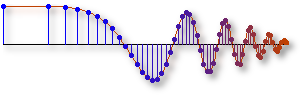Three-Domain Connections
Each movie illustrates how the frequency response of an IIR filter depends on its pole locations, because poles near the unit circle produce narrowband peaks. Also the dependence of the impulse response on the poles can be observed, by noticing the decay rate and oscillation period of \(h[n]\).
|
IIR filter with one pole and a zero at the origin \((z=0)\). The pole is moved from left to right, starting at \(z = -0.9\) and ending at \(z = +0.9\). Notice that the impulse response decays very little when the pole is near the unit circle. The frequency response also changes from a highpass filter when the pole is near \(z = -1\) to a lowpass filter when the pole approaches \(z = +1\). |
|
|
IIR filter with one pole and one zero. First, the zero is moved from left to right, starting at \(z = -1\) and ending at \(z = +1\). Then the pole is moved from right to left, starting at \(z = +0.75\) and ending at \(z = -0.75\). Notice that the frequency response changes from a lowpass filter to a notch filter and then to a highpass filter. |
|
| Movement of Poles. IIR filter with two poles and a zero at \(z = -1\). The pole pair is complex, at an angle of 45 degrees. During the movie, the radius of the pole pair is varied to illustrate the effect of moving the poles very close to the unit circle. Notice that the decay rate of the impulse response changes, but the oscillation period remains the same. The frequency response becomes a very sharp bandpass filter as the poles approach the unit circle. |
|
| Angular Movement of Poles. IIR filter with two poles and a zero at \(z = -1.\) The pole pair is complex, at a radius of \(|z| = 0.95.\) During the movie the angle of the pole pair is varied, to illustrate the effect of moving the poles around the unit circle. Notice that the decay rate of the impulse response stays the same, but the oscillation period changes. The frequency response is a very sharp bandpass filter whose center frequency changes as the poles move in angle. |
|
|
Movement of Zeros in an IIR Filter. IIR filter with two poles and a zero at \(z = -1\). The zero is moved from \(z = -1\) to \(z = +1\) during the movie. The pole pair is complex, at an angle of 45 degrees and radius 0.95. Notice that the decay rate and oscillation rate of the impulse response remain the same. The zero should have no effect on the "tail" of \(h[n]\), but the second sample in \(h[n]\) does change, which sets up an initial condition for the rest of \(h[n]\). Likewise, the frequency response is not very sensitive to changes in the zero location; its center frequency and bandwidth remain more or less the same, although the peak height does vary noticeably. |
|
|
Radial Movement of Two out of Four Poles. IIR filter with four poles and a zero at \(z = -1\). One complex pole pair is fixed, at a radius of \(0.95\) and an angle of 30 degrees. The other pole pair has a fixed angle of 90 degrees, but during the movie the radius of this pole pair is varied, to study the interaction of the poles and the reulting impact on the frequency response. The fixed pole pair causes a peak in the frequency response, but that peak does not change significantly as the other pole pair is varied. |
|
|
Angular Movement of Two out of Four Poles. IIR filter with four poles and a zero at \(z = -1\). One complex pole pair is fixed, at a radius of \(0.95\) and an angle of 30 degrees. The other pole pair has a fixed radius of \(0.9\), but during the movie the angle of this pole pair is varied, to illustrate the effect of moving the poles close to one another. Notice the interaction of the poles and the reulting impact on the frequency response. The fixed pole pair causes a peak in the frequency response, and that peak does not change significantly until the other pole pair gets relatively close. |
